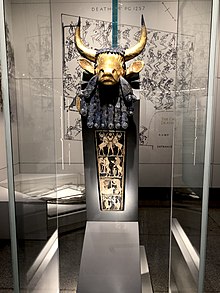| Bull Headed Lyre of Ur | |
|---|---|
 Bull Headed Lyre of Ur as displayed in the Penn Museum | |
| Material | Gold, silver, copper, bitumen, shell, & lapis lazuli |
| Size | Head dimensions: 40 cm long, 25 cm wide, 19 cm deep |
| Created | 2550–2450 BCE |
| Present location | Penn Museum, Philadelphia |
| Identification | Penn Museum Object Number B17694B |
The Bull Headed Lyre is one of the oldest string instruments ever discovered. The lyre was excavated in the Royal Cemetery at Ur during the 1926–1927 season of an archeological dig carried out in what is now Iraq jointly by the University of Pennsylvania and the British Museum. Leonard Woolley led the excavations.
The lyre was found in “The King’s Grave”, near the bodies of more than sixty soldiers and attendants.[1] It is one of several lyres and harps unearthed at the cemetery which date to the Early Dynastic III Period (2550–2450 BCE). The lyre was included in the first batch of materials taken to the University of Pennsylvania Museum of Archaeology and Anthropology (the Penn Museum) in 1929.[1] The piece consists of a sound box, a quadripartite panel and a sculpted bull's head. Over the years it has undergone extensive conservation and restoration work.
© MMXXIII Rich X Search. We shall prevail. All rights reserved. Rich X Search
